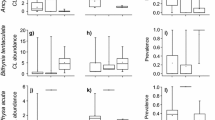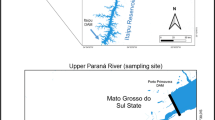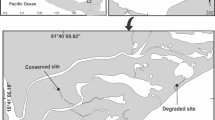Abstract
The impact of a drought on freshwater snail and trematode communities was investigated in a lake. Before the drought, 15 gastropod species (Valvatidae, Planorbidae, Lymnaeidae, Ancylidae, Physidae) and 10 trematode species (cercariaeum, xiphidiocercariae, echinostome, furcocercariae, notocotyle, lophocercous) were recorded. The rate of parasitism was 5.13% and there were 11 host species. The 2 major consequences of desiccation were the disappearance of snails, except Valvata piscinalis and Lymnaea peregra, and the absence of trematodes infecting the surviving snails. As soon as favourable conditions were restored, the littoral area was recolonized, first by hygrophilic and amphibious species, second by aquatic species. Nine months after the drought, the gastropod community was restored. Recolonization by the trematodes was delayed compared with that of gastropods. During the study, the overall prevalence was equal to 0.36% and only 4 trematode species and 5 host species were recorded. Because of the great variability of freshwater ecosystems, long-term studies are necessary to understand the dynamics of snail and trematode populations and determine the regulatory effect of parasitism in the field.
Similar content being viewed by others
References
Anderson, R. M., 1978. Regulation of host population growth by parasite species. Parasitology 76: 119–157.
Anderson, R. M. & R. May, 1978. Regulation and stability of hostparasite population interactions. I. Regulatory processes. J. anim. Ecol. 47: 219–249.
Badger, L. I. & J. P. O. Oyerinde, 1996. Schistosoma mansoni – effect of aestivation on the intra-molluscan stages and the survival rate of infected Biomphalaria pfeifferi. Ann. trop. Med. Parasit. 90: 617–620.
Brown, K. M., 1979. The adaptive demography of four freshwater pulmonate snails. Evolution 417–432.
Cheatum, E. P., 1934. Limnological investigations on respiration, annual migratory cycle and other related phenomenan in freshwater pulmonate snails. Trans. am. microsc. Soc. 53: 348–407.
Crews, A. E. & G. W. Esch, 1986. Seasonal dynamics of Halipegus occidualis (Trematoda: Hemiuridae) in Helisoma anceps and its seasonal impact on fecundidy of the snail host. J. Parasitol. 72: 646–651.
De Kock, K. N., 1993. The effect of exposure to Schistosoma mansoni on mortality rates of cohorts of different ages of Biomphalaria pfeifferi. Folia parasitol. 40: 9–12.
Dudgeon, D., 1982. The effects of water level fluctuations on a gastropod community in the rocky marginal zone of plover cove reservoir, Hong Kong. Int. J. ecol. envir. Sci. 8: 195–204.
Erasmus, D. A., 1972. The digenetic cycle-larval forms. In Edward Arnold Publishers (ed.), The Biology of Trematodes: 21–27.
Gérard, C., 1997. Importance du parasitisme dans la communauté de Gastéropodes de l'étang de Combourg (Bretagne, France). Parasite 4: 49–54
Gérard, C., 1998. Trematodes as potential regulators in a community of freshwater gastropods. International Proceedings Division (IX International Congress of Parasitology), Monduzzi Editore: 705–709.
Goater, T. M., A. W. Shostak, J. A. Williams & G. W. Esch, 1989. A mark-recapture study of trematode parasitism in overwintered Helisoma anceps (Pulmonata), with special reference to Halipegus occidualis (Hemiuridae). J. Parasitol. 75(4): 553–560.
Hanifa, M. A., 1978. Energy loss in an aestivating population of the tropical snail Pila globosa. Hydrobiologia 61: 169–182.
Harris, R. E. & W. A. G. Charleston, 1977. The response of the freshwater gastropods Lymnaea tomentosa and L. columella to desiccation. J. zool. Soc. Lond. 183: 41–46.
Horst, T. J. & R. R. Costa, 1975. Seasonal migrations and density patterns of the fresh water snail Amnicola limosa. Nautilus 89: 56–59.
Hurd, H., 1990. Physiological and behavioural interactions between parasites and invertebrate hosts. Adv. Parasitol. 29: 271–318.
Khan, R. A. & J. Thulin, 1991. Influence of pollution on parasites of aquatic animals. Adv. Parasitol. 30: 201–238. 18
Lafferty, K. D., 1997. Environmental parasitology: what can parasites tell us about human impacts on the environment? Parasitol. Today 13: 251–255.
Lambert, M. C., 1990. Contribution à la biologie et à l'écophysiologie d'un Lymnaeidae armoricain: Lymnaea peregra (Müller) (mollusque, gastéropode, pulmoné, basommatophore). PhD thesis, Rennes I University, France: 317 pp.
Manga-Gonzalez, Y., C. Gonzales-Lanza & I. Kanev, 1994. Lymnaea truncatula, intermediate host of some Plagiorchiidae and Notocotylidae species in Leon, NW Spain. J. Helminthol. 68: 135–141.
Minchella, D. J., B. K. Leathers & K. M. Brown, 1985. Host and parasite counteradaptation: an example from a freshwater snail. Am. Nat. 126: 843–854.
Okland, J., 1990. Lakes and snails. In Universal Book Services (eds), Oegstgeest. The Netherlands: 516 pp.
Pointier, J. P. & C. Combes, 1976. La saison sèche en Guadeloupe (Antilles françaises) et ses conséquences sur la démographie des mollusques dans les biotopes à Biomphalaria glabrata (Say, 1818), vecteur de la bilharziose intestinale. Terre Vie 30: 121–147.
Pointier, J. P., B. Salvat, A. Delplanque & Y. Golvan, 1977. Principaux facteurs régissant la densité des populations de Biomphalaria glabrata (Say 1818), mollusque vecteur de la Schistosomose en Guadeloupe (Antilles françaises). Ann. Parasitol., Paris 52(3): 277–323.
Richards, C. S., 1963. Apertural lamellae, epiphragms and aestivation of planorbids molluscs. Am. J. trop. Med. Hyg. 12: 254–263.
Russel-Hunter, W., 1961. Annual variations in growth and density in natural populations of freshwater snails in the West of Scotland. Proc. zool. Soc. Lond. 136: 219–253.
Siddall, R., A. W. Pike & A. H. McVicar, 1993. Parasites of Buccinum undatum (Mollusca: Prosobranchia) as biological indicators of sewage-sludge dispersal. J. mar. biol. Ass. U. K. 73: 931–948.
Storey, R., 1972. Dormancy in Lymnaea peregra (Müller) during periods of dryness. J. Conch. 27: 377–386.
Sturrock, R. F., 1970. An investigation of some factors influencing the survival of St-Lucian Biomphalaria glabrata deprived of water. Ann. trop. Med. Parasit. 64: 365–371.
Thompson, S. N., 1985. Review: Metabolic integration during the host associations of multicellular animal endoparasites. Comp. Biochem. Physiol. 81B: 21–42.
Valtonen, E. T., J. C. Holmes & M. Koskivaara, 1997. Eutrophication, pollution and fragmentation: effects on parasite communities in roach (Rutilus rutilus) and perch (Perca fluviatilis) in four lakes in central Finland. Can. J. Fish. aquat. Sci. 54: 572–585.
Woolhouse, M. E., 1989. The effect of schistosome infection on the mortality rate of Bulinus globosus and Biomphalaria pfeifferi. Ann. trop. Med. Parasit. 83: 137–141.
Author information
Authors and Affiliations
Rights and permissions
About this article
Cite this article
Gérard, C. Consequences of a drought on freshwater gastropod and trematode communities. Hydrobiologia 459, 9–18 (2001). https://doi.org/10.1023/A:1012567102396
Issue Date:
DOI: https://doi.org/10.1023/A:1012567102396




